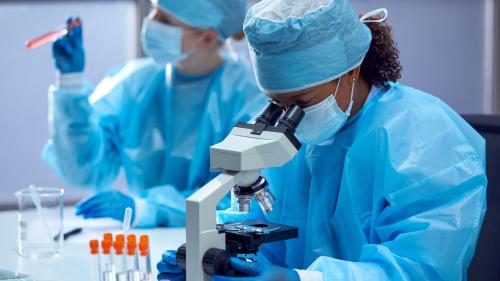
-
Understanding primary immunodeficiency (PI)

Understanding PI
The more you understand about primary immunodeficiency (PI), the better you can live with the disease or support others in your life with PI. Learn more about PI, including the various diagnoses and treatment options.
-
Living with PI
-
Addressing mental health
-
Explaining your diagnosis
- General care
- Get support
- For parents and guardians
-
Managing workplace issues
- Navigating insurance
-
Traveling safely

Living with PI
Living with primary immunodeficiency (PI) can be challenging, but you’re not alone—many people with PI lead full and active lives. With the right support and resources, you can, too.
-
Addressing mental health
-
Get involved

Get involved
Be a hero for those with PI. Change lives by promoting primary immunodeficiency (PI) awareness and taking action in your community through advocacy, donating, volunteering, or fundraising.
-
Advancing research and clinical care
-
Research Grant Program
-
Consulting immunologist
-
Diagnosing PI
-
Getting prior authorization
-
Clinician education
-
Survey research
-
Participating in clinical trials

Advancing research and clinical care
Whether you’re a clinician, researcher, or an individual with primary immunodeficiency (PI), IDF has resources to help you advance the field. Get details on surveys, grants, and clinical trials.
-
Research Grant Program
As an organization dedicated to supporting people with primary immunodeficiencies (PI), the Immune Deficiency Foundation (IDF) believes that persons with severe combined immunodeficiency (SCID) should receive lifelong follow-up care after treatment for the disorder.
A person with SCID is born without a functioning immune system, making the disorder one of the most life-threatening of the 400+ PI forms that exist. SCID is fatal if not treated with hematopoietic stem cell transplant (HSCT) or clinical trial gene therapy.
HSCT has been the standard treatment for SCID for over 40 years. Gene therapy clinical trials for SCID have been conducted over the last 20 years. Though these treatments are necessary for saving the lives of persons with SCID, the treatments are not without their complications and success rates.
While the goal of these treatments is full immune system restoration, medical problems may arise months to years after a transplant from side effects due to the treatments and/or from the failure of the reconstituted immune system to thrive. Factors that can affect immune system reconstitution include the type of SCID, infections before diagnosis, donor match, HSCT treatment protocol, gene therapy vector, and use of immunosuppressant drugs.
IDF highly recommends annual lifelong medical evaluation of all persons with SCID – regardless of age, treatment type, or treatment timeline – in order to ensure their immune systems are functioning normally and to identify any side effects from treatment.
The following are long-term complications that can arise in post-treatment for SCID.
Chemotherapy late effects
Transplant specialists sometimes administer chemotherapy for both stem cell transplant and gene therapy. There are both short-term and long-term side effects. The late effects from chemotherapy can occur from a few months to years after chemotherapy is administered. Some of those effects may damage the heart and lungs, and cause infertility, cognitive impairment, delayed growth, dental problems, hearing loss, increased risk of other cancers, loss of taste, nerve damage, and osteoporosis.
Chronic graft versus host disease
Graft versus host disease (GVHD) is the most common serious transplant-related complication. Chronic GVHD occurs after HSCT as a result of the donor cells attacking the tissues of the recipient. Manifestations of chronic GVHD may be restricted to a single organ or tissue, or it may affect many organ systems. Chronic GVHD has features that resemble autoimmune disorders. Symptoms could include skin thickening, itchy skin, rash, hair loss, joint and muscle pain, dry or teary eyes, blurred vision, sore mouth, chronic cough and trouble breathing, nausea, diarrhea, and stomach pain.
Infections
Infection remains an important complication during transplantation and, with GVHD, is the most significant contribution to morbidity and transplant-related mortality. Infections can be either those that occurred before the time of transplant or around the time of the transplant. During the first month of post-transplantation, the risk of infection conferred by the pre-existing immunodeficiency is compounded by the following: breakdown of anatomical barriers, such as the skin and mucosal surfaces; agranulocytosis (severe lowered white blood cell count), if conditioning has been given; and T and B lymphocyte deficiency. In some patients, pre-existing pathogens, such as Epstein-Barr virus (EBV), can be reactivated. In the late phase following transplantation, infection susceptibility is predominately from bacteria, although those patients with chronic GVHD may remain susceptible to viral and fungal pathogens.
Autoimmunity or immune dysregulation
Autoimmunity or dysregulation of the immune system can occur post-treatment. In autoimmunity, the regulatory cells fail to prevent new stem cells from becoming over-activated, causing an imbalance in the immune system. The condition leads to the body attacking itself resulting in symptoms such as fatigue, trouble concentrating, joint pain and swelling, numbness and tingling in the hands and feet, skin rashes, hair loss, digestive issues, low-grade fever, and swollen glands.
Leukemia
Leukemia, a cancer of the blood, occurred in gene therapy trials conducted in Europe between 1999 and 2006. Since those trials, scientists have changed the type of virus, or vector, used to deliver the corrected gene in gene therapy. In trials of X-linked SCID using new modified vectors, leukemia and lymphoma have not been seen. Additionally, patients with ADA SCID who have undergone gene therapy have never been reported to have leukemia. Scientists think that the chance of developing leukemia from gene therapy using the newer vectors is extremely low, but many more years of follow-up are needed to be sure.
Immune system failure
In some persons with SCID, HSCT treatment appears successful for months to years at a time but then fails to continue providing the recipient with an immune system. In some cases, this waning immune system presents decades after transplant and has no outward symptoms; it can only be diagnosed by monitoring immune system function over a period of years.
In order to address all the possible long-term complications post-treatment, IDF recommends that persons with SCID meet annually with their immunologist to test their immune system function and to address any treatment side effects. Monitoring the immune system ensures that a decline in function is caught early and that treatment side effects can be mitigated.
IDF urges long-term follow-up for SCID in keeping with its mission to improve the quality of life for people with PI and to foster a community empowered by advocacy and education.
Related resources
Sign up for updates from IDF
Receive news and helpful resources to your cell phone or inbox. You can change or cancel your subscription at any time.





The Immune Deficiency Foundation improves the diagnosis, treatment, and quality of life for every person affected by primary immunodeficiency.
We foster a community that is connected, engaged, and empowered through advocacy, education, and research.
Combined Charity Campaign | CFC# 66309




